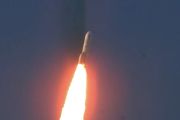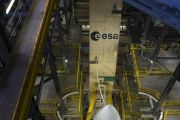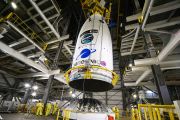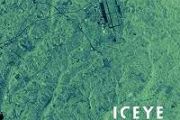
Copernical Team
Virgin Galactic, Blue Origin face off in space tourism market
 The era of space tourism is set to soar, with highly symbolic flights by rivals Virgin Galactic and Blue Origin scheduled just days apart.
Virgin Galactic - founded by flamboyant British billionaire Richard Branson - is planning for a July 11 space flight. Blue Origin - started by Jeff Bezos of Amazon fame - is set to blast off on July 20.
The two companies will serve the nascent mar
The era of space tourism is set to soar, with highly symbolic flights by rivals Virgin Galactic and Blue Origin scheduled just days apart.
Virgin Galactic - founded by flamboyant British billionaire Richard Branson - is planning for a July 11 space flight. Blue Origin - started by Jeff Bezos of Amazon fame - is set to blast off on July 20.
The two companies will serve the nascent mar Earth from Space: Gulf of Martaban

The Gulf of Martaban, an arm of the Andaman Sea located in southern Myanmar, is featured in this false-colour image captured by the Copernicus Sentinel-2 mission.
Chinese Scientists Suggest Launching Dozens of Rockets to Prevent Asteroid Collision With Earth
 The effort is aimed at the asteroid Bennu, a 492m in diameter spinning-top shaped rock, which will pass within 7.5 million kilometers of Earth's orbit between 2175 and 2199. The space rock will be designated as potentially harmful at this time, with scientists predicting a 1-in-2,700 risk of colliding with our planet.
In a newly published research, experts at China's National Space Science
The effort is aimed at the asteroid Bennu, a 492m in diameter spinning-top shaped rock, which will pass within 7.5 million kilometers of Earth's orbit between 2175 and 2199. The space rock will be designated as potentially harmful at this time, with scientists predicting a 1-in-2,700 risk of colliding with our planet.
In a newly published research, experts at China's National Space Science Mechanical arm is Chinese astronauts' space helper
 The mechanical arm installed on China's space station core module Tianhe has played an important role in assisting the astronauts with their extravehicular activities (EVAs) on Sunday.
The mechanical arm is designed to ensure the safe and reliable operation of the space station in orbit, to help the astronauts in EVAs, such as the assembly, construction, maintenance, and repair of the spac
The mechanical arm installed on China's space station core module Tianhe has played an important role in assisting the astronauts with their extravehicular activities (EVAs) on Sunday.
The mechanical arm is designed to ensure the safe and reliable operation of the space station in orbit, to help the astronauts in EVAs, such as the assembly, construction, maintenance, and repair of the spac A touch of sun heats up material scieces at ESTEC
 From ESA's Materials and Electrical Components Laboratory - one of a suite of labs based at the ESTEC technical centre in Noordwijk, the Netherlands - a view from an intricate test campaign for the next generation of European weather satellites.
The near infrared detector assembly of the Flexible Combined Instrument (FCI) imager aboard the Meteosat Third Generation - Imaging (MTG - I) sate
From ESA's Materials and Electrical Components Laboratory - one of a suite of labs based at the ESTEC technical centre in Noordwijk, the Netherlands - a view from an intricate test campaign for the next generation of European weather satellites.
The near infrared detector assembly of the Flexible Combined Instrument (FCI) imager aboard the Meteosat Third Generation - Imaging (MTG - I) sate NASA orders satellite container and trolley from RUAG Space
 RUAG Space, a leading supplier to the space industry, received a direct order from NASA's Jet Propulsion Laboratory in Pasadena, California, and will deliver a large satellite container and a multipurpose trolley for NASA satellites. The total order volume for both container and trolley is worth approximately 2 million Euros.
b>Reusable container for three NASA missions br> /b>
From 2022
RUAG Space, a leading supplier to the space industry, received a direct order from NASA's Jet Propulsion Laboratory in Pasadena, California, and will deliver a large satellite container and a multipurpose trolley for NASA satellites. The total order volume for both container and trolley is worth approximately 2 million Euros.
b>Reusable container for three NASA missions br> /b>
From 2022 Exercise bike in space helps keep crew fit
 During a recent video sent from the core module of China's space station Tianhe (Harmony of Heavens), an exercise bike attracted lots of attention from viewers.
China launched its seventh manned spaceflight Shenzhou XII, on June 17, with three astronauts aboard for a three-month mission, during which they require regular exercise.
On June 23, astronaut Nie Haisheng opened a package c
During a recent video sent from the core module of China's space station Tianhe (Harmony of Heavens), an exercise bike attracted lots of attention from viewers.
China launched its seventh manned spaceflight Shenzhou XII, on June 17, with three astronauts aboard for a three-month mission, during which they require regular exercise.
On June 23, astronaut Nie Haisheng opened a package c Homemade spacesuits ensure safety of Chinese astronauts in space
 China's self-developed spacesuits have ensured the safety of astronauts during their stay in the space station core module Tianhe and while performing extravehicular activities (EVAs) outside the module.
The space gears include intravehicular spacesuits and extravehicular spacesuits, according to different scenarios, said Zhang Wanxin, director of the astronaut suit project under the Astro
China's self-developed spacesuits have ensured the safety of astronauts during their stay in the space station core module Tianhe and while performing extravehicular activities (EVAs) outside the module.
The space gears include intravehicular spacesuits and extravehicular spacesuits, according to different scenarios, said Zhang Wanxin, director of the astronaut suit project under the Astro Thousands of galaxies classified in a blink of an eye
 Astronomers have designed and trained a computer program which can classify tens of thousands of galaxies in just a few seconds, a task that usually takes months to accomplish.
In new researchm astrophysicists from Australia have used machine learning to speed up a process that is often done manually by astronomers and citizen scientists around the world.
"Galaxies come in different
Astronomers have designed and trained a computer program which can classify tens of thousands of galaxies in just a few seconds, a task that usually takes months to accomplish.
In new researchm astrophysicists from Australia have used machine learning to speed up a process that is often done manually by astronomers and citizen scientists around the world.
"Galaxies come in different New clues to why there's so little antimatter in the universe
 Imagine a dust particle in a storm cloud, and you can get an idea of a neutron's insignificance compared to the magnitude of the molecule it inhabits.
But just as a dust mote might affect a cloud's track, a neutron can influence the energy of its molecule despite being less than one-millionth its size. And now physicists at MIT and elsewhere have successfully measured a neutron's tiny effe
Imagine a dust particle in a storm cloud, and you can get an idea of a neutron's insignificance compared to the magnitude of the molecule it inhabits.
But just as a dust mote might affect a cloud's track, a neutron can influence the energy of its molecule despite being less than one-millionth its size. And now physicists at MIT and elsewhere have successfully measured a neutron's tiny effe 


































